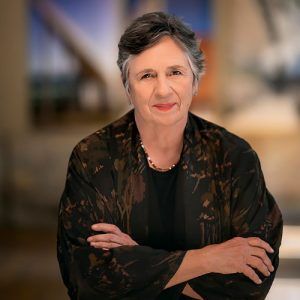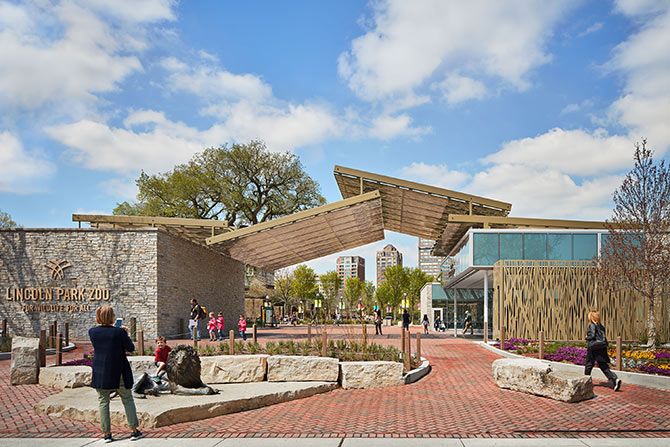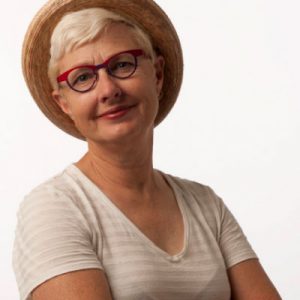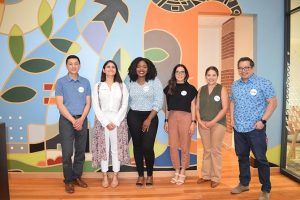
Carol Ross Barney is the AIA National’s 2023 Gold Medal Winner. She is also the Keynote Speaker for the 2023 AIA Utah Fall Conference. We chatted with her about her career, about women in architecture, what led to her success and the primary points of her address. The following are excerpts from our conversation.
You decided to become an architect when you were in high school, right?
Yes, I went to a Catholic girl’s high school, and I think I was the first architect that they had ever had. I loved making things for as long as I can remember. And I believe, personally, that everybody should leave the planet a better place. There were a whole lot of jobs that didn’t have that potential. I didn’t know any architects. I just sort of, in my little high school mind, decided that this was really a good fit — that I could save the world and make things better.
Who inspired you?
Some of the politicians and figures of the time: Martin Luther King, Jr. and John F. Kennedy. Kennedy was elected in 1960. So, I was in seventh grade, and he just set a whole new idea about who Americans were and what they could be. That was definitely inspiring to me. I have a really strong interest in social justice.
As for buildings, I was inspired by a lot of the modernists. I didn’t know what I was looking at particularly, but I am in Chicago, and so I watched some really amazing buildings go up, even in my youth. I was always inspired by the ambition of the modernist period buildings. These buildings were using new materials and daylight, and they were just so transparent and beautiful.
As I started practicing architecture, working for Holabird and Root, my first boss was John Holabird. He was a true mentor. He didn’t necessarily give me things, but you could tell that he thought I could do it.
I was really close friends with Natalie de Blois, the first woman to be an Associate Partner at Skidmore, Owings and Merrill here in Chicago. Her career was really different than mine. She was super talented, but she worked in the corporate structure. She told me that once she and SOM Design Leader, Gordon Bunshaft, were going to a project meeting. He told her that he didn’t like her dress and she went home and changed it. That was not like Natalie; she was a super independent person. But she was willing to put up with the BS to get the rest done. Also, she had four sons, and I didn’t know women architects who had children. So, looking at her career was really fascinating.
And then I had a friend, a colleague, Ken Groggs. He was one of the founders of the National Organization of Minority Architects. We were in AIA together. When I met him, I had just started my practice, and he had just started his. He and I were talking, and I was telling him how hard it was for me to find clients. I didn’t even know who to talk to. And he said, “Come over to my office.” I sat across his desk, and he took out his Rolodex. He said, “Okay, do you have a pencil? I’m going to tell you who to call.” He had been in government for years doing public work — being the client — and he gave me his entire Rolodex. That influenced how I practice architecture. I think it made me more collaborative. I recognized that it’s not what I can do — what I can accomplish — it’s convincing other people or helping other people.
Frustrations, disappointments?
One thing people may not realize about our profession is how many buildings you draw that don’t get built or how many interviews you go to for projects you don’t get. There are probably thousands of those disappointments on the way.
Especially when you’re starting a practice, they can be extraordinarily personal. And so, yeah, I had the same hurt as every other architect. There are problems women architects have that are unique, and they come from the culture of the firm. Those things are real, and they affect everything that you do in the office. I don’t think it is as blatant now. I had a senior partner chase me around his desk, trying to give me a birthday kiss when I was 21 years old. It’s like, what do I do now? Even if you were pretty confident about yourself, what do I do now?
And what did you do?
I think I kept running! I think we went around and around and around that desk many times.
I flunked my first college design course because the Teaching Assistant told me that he didn’t think women should be architects. I expected to have some resistance, and coming from this girls’ school, I was prepared to break all doors down, but I wasn’t expecting it to be that blatant. In a way, it makes you more resilient; it makes you more determined to do it. I had to appeal to the Dean and get my grade changed.
Those are frustrations of a different kind. I’ve been in my own practice for 40 years and have a few accolades on my side. But as recently as four years ago, we were the design architect to a big engineering/architecture project, and the architect on their staff told me, “Don’t talk in the meetings unless I tell you to.” He said the same to our partner in charge of the job, who was also a woman. So I thought, “Okay, we know what’s happening here.” The interesting thing, though, is that nobody’s willing to cross him because there’s still this sort of patriarchy that exists in architectural firms, especially ones that are more traditional.
Beyond that, architecture is not easy. Basically, you’re trying to convince people to trust you with millions and millions and millions of their dollars. When people say, “Oh wow, that’s really a nice building,” I see what I didn’t get done. “Don’t they see that detail?” or “Don’t you see where they cut costs?” or “This piece is not as perfect as it should be.” I truly believe architects are optimistic because if you weren’t, you wouldn’t do this.
Was there ever a point in your career where you had to just take a leap of faith?
When I started my office, that was a leap of faith. I was Director of Design for a company in Chicago, and we merged with another company. I was pretty unaware, but I soon found out that there was a fight to predict who was going to be the director. I lost before I even knew I was in it. I got a call from a couple of the clients I was working for. They said, “We still want you to be our architect.” Honestly, I had never thought about opening a firm. I was more interested in the project than I was in building an office. And I remember thinking, “Well, maybe this isn’t such a weird idea.” I went to the bank and opened a checking account for my business — that was a huge leap of faith for me.
What did it take to make it successful?
That client, which was a local college, gave us a commission, and immediately right after that, probably a half dozen more clients came. The other thing I learned is usually you’re hired because of a relationship, not because of a design. So, I knew these people, and they hired me. They didn’t hire me for as big of jobs as I did for Holabird, but they hired me.
The stunner came about six months later when I found out that everybody who had ever wanted me to be their architect had already called. It was discouraging. It was really discouraging. But I think most founding Principals would tell you the same story. Very, very few people get it on a silver platter.
When I mentor young new firm owners, people who are trying to start practices, I tell them they need the portfolio, they need the experience and they need mentors. They need to nurture relationships because relationships open doors to opportunities.
How do you personally do it?
It’s taken me a while, but I have developed the right persona for me and for my studio over the years. I found out that I was much better at competing in the public arena. Sometimes people hired me just because they got points for hiring a woman. That was part of our social-political culture — something you should do. And it’s not enough to build a firm on, but it was helpful in winning some commissions.
There are some things I’m really good at, and there are some things I’m really bad at. I think that one of my talents is realizing what those are and finding someone to fill in my gaps. One of my partners is my Marketing Director and Principal. She does what I don’t do. I’m a social pygmy. I’m a terrible conversation-maker in a crowded situation. I’m great one-on-one, and I’m really good when I’m talking to hundreds. But that middle situation where you’re in a crowd and you have to talk, I’m so bad at it. We’ve been working together for years, and she’s really the architect of our strategy for business development and marketing the firm. I have other people in my studio who fill in other gaps that I just don’t do very well.
That was an important realization — I’m not competing with everybody. In fact, together, we were making a whole. It’s not about modesty, either. I mean, I do some things really well, and you better let me do them or I won’t work with you.
Tell me about speaking to hundreds at the conference. What are you going to talk to us about?
I’m going to talk about our practice for the last 15 or 20 years. Formally, we offer architecture, landscape architecture and planning. But we have found a fertile area in building infrastructure. It’s made me really interested in the pieces that make cities work and what they’ll be like in the future. The thing I think architects need to hear — and like to hear — is that we are the members of the design team who envision the entire project.
What are you particularly proud of?
The Riverwalk took 15 years of my life, and I like the project. I think we did a really good job. But the thing that just floors me is the way it affects people. The other day, I was sitting on the riverwalk waiting for somebody. I always feel at home in my projects, but this one has grown to be a thing of its own. I felt like I was seeing something new, and it wasn’t something bad. It was just that everybody had adapted to it. It is their project, and that was stunning.
I have projects that I love, just because they turned out beautifully. We did a little Civil Engineering building for the University of Minnesota, Duluth, and it’s just a very boisterous, expressive building. It talks about materiality in the Iron Range. It has really visual references to the job of civil engineers, like storm control. We have these big scuppers that hang off the building. So, you see the stormwater rushing off the roof and being retained in these big Corten barrels. I like that building because it talks.
How do you pitch these creative ideas to people who are very utilitarian and very budget-minded?
I just had this discussion with another architect today. They were saying, it doesn’t matter what the budget is; you have to do what’s right for the design. Okay, Rule Number One in public architecture, the design has to be right for the budget. That argument never works. It just doesn’t.
First, we try to explain the value. We tell clients that there are thousands of good solutions, but they have to be good solutions for all the invested parties. We have to find two or three that we will show them. We often say we are showing you the dumb solution. This is the one you’ve seen before. It works. We would build it for you. It’s a very solid solution.
Then usually, we like to show the solution that’s 180 degrees from that one, the one you never thought of. It still meets all the criteria. And maybe we’ll show the one or two in between. The important thing, especially working in a public capacity, is the designs that we propose have to be integrated, and they have to be holistic. That the design doesn’t just work really well as a classroom or other building type, it has to work from a cost standpoint as well, and it has to have the ability to relate to the people that are using it. If you don’t hit all those goals, you’re going to get thrown out. It doesn’t matter what you think.
One mistake I see when I am on design juries or reviews is that an architect will have a really good idea, and they’ll show it to you three different ways. That’s a loser. Or the contrary is they’ll have one really good idea, and then they’ll have two that they don’t like, so they’ll draw them really ugly. That’s a loser, too. The client is going to pick the ugly one.
How do you provide a number of design solutions for a client without blowing your design budget?
That’s hard. In fact, when I’m working for the federal government, I’m regulated under the Brooks Act by how much I can charge them. So, we’ve learned to do it really efficiently.
We learned a big thing working on the Oklahoma City Federal Building that replaced the Alfred P. Murrah Federal Building after the terrorist bombing. The GSA asked us to engage with the survivors and city officials because it was such an emotionally and culturally difficult project. And we did a lot of things wrong. But we did develop this rich base of information and opinion. So we started to think that we should do this for every project. Over the years, we have developed a really robust set of tools to do engagement. I think it’s so interesting that a lot of clients hire us to do that in addition to design, they’re willing to pay for it as an outside service, especially communities, which are the ones who need it the most.
To get the research done, to discover really innovative solutions: talk to people.
What do you think is the most challenging right now for women architects?
Things are changing. I’ve taught at IIT for 30-some years. Half of my classes are filled with women now. The place where people are still frustrated is getting to the level of firm ownership and firm leadership; women still lag in those areas. There’s still a lack of opportunity for women architects. You don’t get the opportunity because you don’t have a portfolio, and you don’t have a portfolio because you don’t get the opportunity. There are fewer ladders that are available to women.
I hope that one of the things that my winning the gold medal changes is people’s perception. The past examples we have of women winning the gold medal are Julia Morgan — who has been deceased for 60 years — and the two medalists, very wonderful architects, but they’re married to their partners, which is a different experience than most women architects encounter. It is forward progress. In the 50s or 60s, you couldn’t get a mortgage without a husband, and you couldn’t get a credit card without a husband. Now you can get a gold medal without a husband. It’s really good.
What do you think the most challenging thing is right now in architecture?
The most challenging thing for architects and architecture is convincing our clients — insisting that our clients build the most sustainable designs. If we don’t, the planet will still be here; it just won’t be inhabitable. When you look at design, sustainability is just one criterion amongst a whole group of the good that buildings do, but right now, it’s an existential requirement.
Awards and Distinctions
Carol Ross Barney, FAIA, HASLA, is the 2023 American Institute of Architects Gold Medal recipient and is in the vanguard of civic space design with a career that spans over 50 years. She is dedicated to the design of public spaces, from small community facilities to campus buildings for premier academic and research institutions to groundbreaking new transit stations and civic and urban places. Her exploration into the power of how the built environment can improve our daily lives has produced distinctive structures that have become cultural icons.
As an architect, urbanist, mentor and educator, she has relentlessly advocated that excellent design is a right, not a privilege. For nearly two decades, Carol’s studio has been working along Chicago’s Rivers, including the design of the Chicago Riverwalk and a vision for improvements for all 150 miles of riverfront.
Other notable projects include the design of the new Oklahoma City Federal Building that replaced the Murrah Federal Building following a domestic terrorist attack; the CTA Cermak and Morgan Street Stations; McDonald’s Chicago and Disney World Flagship Restaurants; the Searle Visitor Center at the Lincoln Park Zoo; the JRC Synagogue in Evanston; UMD Civil Engineering Building; Multi-Modal Terminal at O’Hare International Airport; NASA Aerospace Communications Facility and Chicago’s new DuSable Park.
Carol’s work has been honored with over 200 major design awards, including the Cooper Hewitt Smithsonian Design Museum, the National Design Award, fourteen National American Institute of Architects Honor Awards for Architecture, Interior Architecture and Urban Planning and Design, over 44 AIA Chicago Awards, and two AIA Committee on the Environment, Top Ten Project Awards for sustainably designed buildings.
Carol is a graduate of the University of Illinois and served as a U.S. Peace Corps volunteer in Costa Rica, planning national parks. She has taught an advanced Design Studio at the Illinois Institute of Technology for over 30 years.









